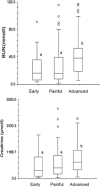Clinical findings and diagnostic procedures in 270 small ruminants with obstructive urolithiasis
- PMID: 29660779
- PMCID: PMC5980268
- DOI: 10.1111/jvim.15128
Clinical findings and diagnostic procedures in 270 small ruminants with obstructive urolithiasis
Abstract
Background: Details of the clinical signs of obstructive urolithiasis in male small ruminants have not been documented in a large population.
Objective: To describe the clinical presentation and diagnostic procedures in a large group of small ruminants with urolithiasis.
Animals: Two hundred and seventy small ruminants (158 sheep and 112 goats).
Methods: Retrospective study of 270 cases identified based on clinical records.
Results: 81.2% affected goats were castrated and 91.7% sheep were intact males; 65.5% of the animals had been sick ≤2 days before referral. Common abnormalities included dysuria (93.6%), indigestion (84.4%), reduced general state of health (79.5%), signs of pain (73%), increased heart and respiratory rates (53.6% and 39.1%), and azotemia (89.4%). Blood urea nitrogen (BUN) and creatinine concentrations were strongly correlated (r2 = 0.81). Hypochloremia (52.2%), hyponatremia (43.3%), hypophosphatemia (52.4%), and abnormal potassium concentrations (26.2% hypokalemia and 24.5% hyperkalemia) were the most common serum electrolyte imbalances. Packed cell volume (PCV), plasma proteins, potassium, BUN, and creatinine concentrations were significantly increased in animals with uroperitoneum. Ultrasonography allowed for confirmation of diagnosis in 83.9% of the cases (135/161 with sufficient available information), uroliths were visible on 34 of 56 plain radiographs.
Conclusions and clinical importance: Our study confirmed that clinical and ultrasonographic examinations are sufficient to diagnose urolithiasis. Clinical signs can be divided into an early stage with discrete unspecific clinical signs, a painful stage with frequent straining, expression of pain and moderately reduced general condition, and an advanced stage with a markedly reduced general condition and eventually recumbency.
Keywords: clinical signs; diagnosis; goats; sheep; urinary calculi.
Copyright © 2018 The Authors. Journal of Veterinary Internal Medicine published by Wiley Periodicals, Inc. on behalf of the American College of Veterinary Internal Medicine.
Figures


References
-
- Videla R, van Amstel S. Urolithiasis. Vet Clin North Am Food Anim Pract. 2016;32:687–700. - PubMed
-
- Smith M, Sherman D. Urinary System In: Smith M, Sherman D, eds. Goat Medicine. 2nd ed. Oxford: Wiley‐Blackwell; 2009:537–569.
-
- Hay L. Prevention and urolithiasis in sheep. In Pract. 1990;12:87–91.
-
- Van Metre D. Obstructive urolithiasis in ruminants: surgical management and prevention. Compend Contin Educ Pract Vet. 1996;18:275.
MeSH terms
Substances
LinkOut - more resources
Full Text Sources
Other Literature Sources

